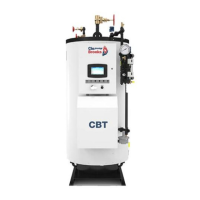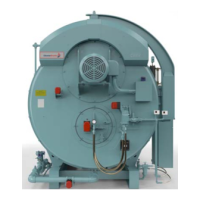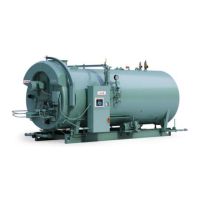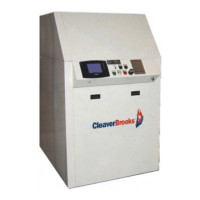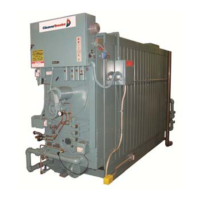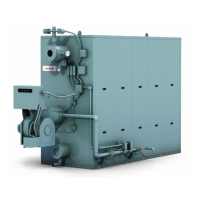Waterside Care and Requirements
3-14
750-91 (revised 2009)
Model CB-LE Packaged Boiler Manual
Check all water and steam piping and valves for leaks, wear, corrosion, and other damage. Replace or repair as
required.
3.10 — Preparation for Extended Lay-Up
Many boilers used for heating or seasonal loads or for standby service may have extended periods of non-use. Spe-
cial attention must be given to idle boilers so that neither waterside nor fireside surfaces are allowed to deteriorate
from corrosion.
Too many conditions exist to lay down definite rules. There are two methods of storage: wet or dry. Your local
Cleaver-Brooks authorized representative can recommend the better method depending upon circumstances in the
particular installation.
Whichever method is used, common sense dictates a periodic recheck of fireside and waterside conditions during
lay-up to allow variations from the above methods for special area or job-site conditions.
Swing open the boiler head at the stack end of the unit to prevent flow of warm, moist air through the boiler tubes.
Although pollution control regulations may continue to limit the permissible sulphur content of fuel oils, care must
be taken to avoid corrosion problems that sulphur can cause, especially in a boiler that is seasonally shut down.
Dormant periods, and even frequent shutdowns, expose the fireside surfaces to condensation below the dew point
during cooling. Moisture and any sulphur residue can form an acid solution. Under certain conditions, and espe-
cially in areas with high humidity, the corrosive effect of the acid will be serious enough to eat through or severely
damage boiler tubes or other metal heating surfaces during the time that a boiler is out of service.
The condition does not generally occur during normal firing operation, because the high temperature of operation
vaporizes any condensation. However, proper boiler operation must be maintained, especially with a hot water
boiler, to prevent the flue gasses from falling below the dew point.
At the start of lay-up, thoroughly clean the fireside by removing any soot or other products of combustion from
the tubes, tube sheets, and other fireside surfaces. Brushing will generally suffice. Sweep away or vacuum any accu-
mulation. The fireside surfaces may be flushed with water. However, all moisture must be eliminated after flushing
and the surface dried by blowing air or applying some form of heat. It is good practice to protect the cleaned sur-
faces by coating them with an anti-corrosive material to prevent rust.
T prevent condensation from forming in the control cabinet, keep the control circuit energized. For extended lay-
up periods, especially where high humidity or large swings in ambient temperature occur, the control should be
removed and stored in a dry atmosphere.
Dry storage is generally employed when the boiler will be out of service for a significant period of time, or where
freezing temperatures may exist. In the dry storage method the boiler must be thoroughly dried because any mois-
ture would cause corrosion. Both fireside and waterside surfaces must be cleaned of all scale, deposits, soot, etc.
Steps must be taken to eliminate moisture by placing moisture-absorbing materials such as quick lime (at 2 pounds
for 3 cubic feet of volume) or silica gel (at 5 pounds for 30 cubic feet of volume) on trays inside the vessel. Fireside
surfaces may be coated with an anti-corrosive material, or grease or tar paint. Refractories should be brushed clean
and wash-coated. All openings to the pressure vessel, such as manhole and handholes, should be shut tightly. Feed-
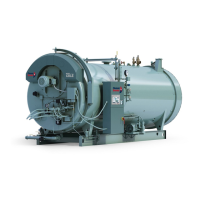
